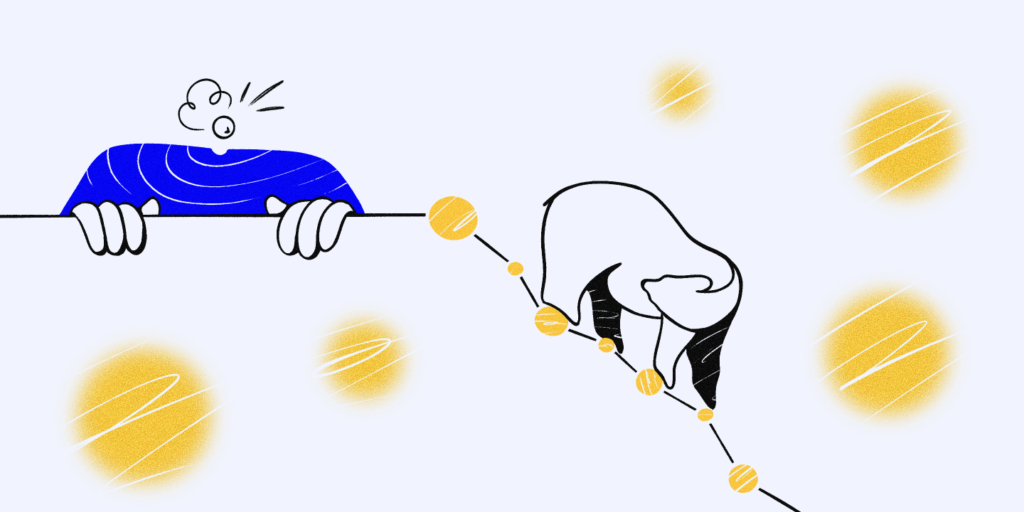A bear market may seem intimidating, but understanding its causes, stages, and potential opportunities may help you make informed decisions. In this guide, we’ll break down everything you need to know about bear markets and how to navigate them successfully.
What is a bear market? Causes, history & stages

Table of Contents
What is a bear market?
A bear market refers to a sustained decline in stock prices, generally defined as a drop of 20% or more from recent highs in major stock indices like the S&P 500 or Dow Jones Industrial Average.
Bear markets often coincide with economic slowdowns, declining corporate earnings, or external events such as financial crises or geopolitical instability.
Key things to know about the bear markets:
- They are part of market cycles – Historically, markets have experienced multiple bear markets, followed by recoveries.
- They vary in length – On average, bear markets last between 9 and 18 months, though durations can differ.
- Not all stocks decline at the same rate – Some sectors, such as healthcare and utilities, have historically been less volatile during downturns.
- Market downturns may create opportunities – Some long-term investors use bear markets as a time to evaluate stocks at lower prices.
Understanding the causes and historical trends of bear markets may help you maintain a long-term perspective rather than react impulsively to market fluctuations.

What may cause a bear market? Real-world examples from the history
1. Economic slowdown
When economic growth slows or contracts, corporate profits may decline, unemployment can rise, and consumer spending may weaken. These factors can contribute to a bear market as businesses face challenges in sustaining growth.
Example: The 2008 Great Recession
The 2008 Great Recession was triggered by a combination of housing market collapse, credit crises, and reduced consumer spending, leading to a bear market that lasted 17 months (October 2007 – March 2009), with the S&P 500 losing nearly 50% of its value.
2. High inflation
Inflation reduces the purchasing power of money, making goods and services more expensive. When inflation rises too quickly, it can put pressure on consumers and businesses, potentially slowing economic growth.
Example: 2022 Inflation Surge
In 2022, inflation in the U.S. reached 9.1%—the highest since 1981. The Federal Reserve responded with aggressive interest rate hikes, leading to market uncertainty and pushing the S&P 500 into bear market territory, with a decline of over 20% from its January 2022 high.
3. Rising interest rates
The Federal Reserve may raise interest rates to control inflation, but higher rates can make borrowing more expensive for businesses and consumers. This can result in:
- Increased debt costs for companies
- Reduced consumer spending on financed purchases like homes and cars
- Lower stock valuations, as future earnings become less attractive
Example: 1980–1982 Interest Rate Hikes
Under Fed Chair Paul Volcker, interest rates were raised to over 19% to combat inflation, contributing to a recession and a bear market that saw the S&P 500 decline by 27% between November 1980 and August 1982.
4. Corporate earnings decline
Stock prices are influenced by corporate earnings expectations. When companies report declining profits or lower-than-expected growth, investors sell shares, leading to price drops. If this happens on a broad scale, it can trigger a bear market.
Example: 2001 Dot-Com Bubble Burst
In 2001, the dot-com bubble burst, leading to a major bear market. Many overvalued tech stocks, with little to no profits, saw their valuations collapse. The decline wiped out approximately $5 trillion in market value, contributing to a prolonged bear market.
5. Market speculation and bubbles
When stock prices rise too quickly without strong underlying business fundamentals, speculation can create asset bubbles. If those bubbles burst, it can lead to widespread panic selling.
Example: 2000 Dot-Com Crash
Many technology stocks soared in value despite weak financials. When investor sentiment shifted, the Nasdaq lost 77% of its value between March 2000 and October 2002, pulling the broader market into a downturn.
6. Global events
Unexpected global events like wars, pandemics, and geopolitical tensions can create uncertainty, leading to market sell-offs.
Example: COVID-19 Crash (2020)
In just five weeks (February – March 2020), the S&P 500 dropped over 34%, as lockdowns and supply chain disruptions led to fears of a global economic collapse.
Example: Russia-Ukraine War (2022)
The conflict led to oil price spikes, inflation fears, and global supply chain issues, contributing to the 2022 bear market.
The 4 phases/stages of a bear market
Bear markets don’t occur overnight—they typically unfold in phases, each characterized by different investor sentiment and market behavior. Recognizing these stages may help you understand market trends and maintain perspective during downturns.
1. Distribution phase (Market peak and initial decline)
At the start, stock markets are still elevated, and optimism remains strong. However, early signs of weakness begin to emerge.
- Institutional investors and large funds may start selling positions, while retail investors remain confident.
- Economic warning signs may appear, such as rising inflation, slowing GDP growth, or declining corporate earnings.
- Market volatility increases, but initial declines are often dismissed as routine corrections.
2. Panic phase (Rapid sell-off and high volatility)
A significant event—such as an interest rate hike, financial crisis, or geopolitical instability—can accelerate declines.
- Markets may drop rapidly, with stock indices declining by 20% or more within weeks.
- Many investors react by selling shares, which can amplify volatility.
- The VIX (often called the “fear index”) typically spikes, reflecting increased uncertainty.
- Negative headlines and widespread pessimism often dominate financial news.
3. Stabilization phase (Market bottom and sideways movement)
After the initial sell-off, market declines slowly, but a clear recovery is not yet in place.
- Stock prices trade within a range rather than continuing to fall sharply.
- Economic indicators present mixed signals—some improvement may appear, but uncertainty remains.
- Many investors remain cautious, waiting for clearer signs of economic recovery.
4. Recovery phase (Market rebounds and bull market begins)
As economic conditions improve, confidence begins to return.
- Indicators such as GDP growth, job market recovery, and stronger corporate earnings signal a potential turnaround.
- Stock indices gradually trend upward, often marking the beginning of a new bull market.
- Investor sentiment shifts, and more participants re-enter the market.
How can bear markets affect investors?
A bear market can have a significant impact on investment portfolios, market sentiment, and long-term financial planning. Here’s how it may affect investors.
1. Portfolio value declines
One of the most immediate and noticeable effects of a bear market is the decline in portfolio value. As stock prices drop, the overall worth of investments decreases, which can be concerning for many investors.
- Equity investments, mutual funds, and ETFs may lose value, reducing overall net worth.
- Investors with a high stock allocation may experience significant paper losses, leading to emotional stress.
- Some investors react by selling their holdings, locking in losses instead of waiting for the market to recover.
While bear markets can be challenging, historical trends show that markets have eventually rebounded. Investors who take a long-term approach often navigate downturns by maintaining their investment strategy rather than making impulsive decisions.
2. Increased market volatility
Bear markets are often characterized by high volatility, where stock prices fluctuate significantly over short periods.
- Daily and weekly price swings may become extreme, making short-term trading riskier.
- Many investors react emotionally to sudden drops, which may lead to hasty decision-making.
- Long-term portfolios may experience large fluctuations, which can be stressful for those unaccustomed to market downturns.
While volatility can be unsettling, some investors use these fluctuations to assess potential buying opportunities in stocks that have declined in price.
3. Investor sentiment shifts
Market psychology plays a key role in investing, and during bear markets, sentiment often shifts from optimism to caution or fear.
- Some investors become more risk-averse, moving funds from stocks to perceived safer assets like bonds or cash.
- Negative media coverage and economic uncertainty may amplify concerns, making investors hesitant to enter the market.
- Periods of heightened selling activity may accelerate market declines.
Investor sentiment often fluctuates with market cycles. Historically, investors with a long-term outlook have weathered market downturns by maintaining a diversified approach rather than reacting emotionally.
4. Impact on retirement accounts
For those investing with long-term goals, such as retirement, a bear market may be particularly concerning. A market downturn may significantly affect retirement accounts like 401(k)s and IRAs.
- Retirement accounts like 401(k)s and IRAs may see a temporary reduction in value.
- Retirees who rely on withdrawals may need to adjust their strategy, as selling assets during a downturn can lock in losses.
- Younger investors, who have more time before retirement, may benefit from continued contributions, acquiring stocks at lower valuations.
While bear markets can impact retirement savings, long-term planning strategies—such as portfolio diversification and maintaining consistent contributions—may help mitigate risks.
Bear markets vs. Market corrections
Market corrections are sometimes confused with bear markets since both involve a decline in stock prices. However, the key differences lie in the severity and duration of the downturn.
- Similar initial trends – Both start with a decline in stock prices, which may cause investor concern.
- Short-term vs. Long-term – A market correction is typically a temporary decline of 10–20%, whereas a bear market involves a prolonged drop of 20% or more.
- Emotional reactions – Investors may perceive a correction as the start of a bear market, potentially leading to panic selling.
- Economic factors – Corrections can occur without major economic shifts, whereas bear markets often coincide with broader economic slowdowns.
For instance, the Nasdaq fell 10.4% on March 7, 2025, qualifying as a correction but not a bear market.
Let’s take a closer look at the difference between a bear market and a market correction:
| Feature | Bear Market | Market Correction |
|---|---|---|
| Definition | Decline of 20% or more | Decline of 10-20% |
| Duration | Months to years | Weeks to months |
| Investor Sentiment | High fear, pessimism | Temporary concern |
| Causes | Economic downturns, recessions, crises | Overvaluation, interest rate hikes, temporary fears |
| Examples | 2008 Financial Crisis, COVID-19 Crash | 2018, 2021 corrections |

Strategies for investors during bear markets
Bear markets can be challenging, but having a well-structured strategy may help you navigate downturns more effectively. Here are some key approaches that may be considered.
1. Revisit your risk comfort level
During a bear market, you may find reviewing your comfort with market swings helpful. If your current approach feels out of sync with your financial goals or time frame, you might explore ways to realign.
2. Look at diversification
A mix of different asset types—like stocks, bonds, or ETFs—can respond differently to market changes. Diversifying your portfolio may help you manage risk in changing conditions, depending on your investment strategy.
3. Use a consistent investing schedule
Some investors may choose to continue investing on a regular schedule, even during downturns. This method, sometimes called dollar-cost averaging, spreads out purchases over time without trying to time the market.
4. Keep cash in mind
Holding some cash or liquid assets might provide flexibility during periods of uncertainty. This may be useful for unexpected expenses or for considering new investment opportunities when prices shift.
5. Take a long-term view
Market downturns have occurred in the past and have been part of broader market cycles. While no outcome is guaranteed, staying focused on your overall financial approach may help you manage through periods of volatility.
Conclusion
Bear markets are part of the natural investing cycle and can be influenced by economic downturns, financial crises, and global events. While they may be challenging, understanding their causes, phases, and historical trends may help you make informed decisions.
If you’re looking for a platform to track market trends and explore investment opportunities, Public.com provides real-time data and educational resources to help you navigate all market conditions.
Public is an all-in-one brokerage where you can build a multi-asset portfolio that includes everything from stocks, options, bonds, crypto, treasuries and a High-Yield Cash Account. As a member, you’ll gain access to a powerful suite of tools and data, including our Income Hub, which lets you track monthly earnings from all your interest and dividend-paying assets and forecast your income for the year ahead.

Frequently asked questions
What signals the end of bear market?
There’s no single indicator that marks the end of a bear market, but historically, certain patterns have been observed. These may include improvements in economic data, policy changes from central banks, stronger corporate earnings, or shifts in overall market sentiment. While such signals have aligned with past market recoveries, they don’t guarantee a specific outcome.
Is a bear market the same as a recession?
Not always. A bear market is a 20% or more decline in stock prices, while a recession is an extended economic downturn with falling GDP, job losses, and lower consumer spending. The two can overlap, but they don’t always occur together.